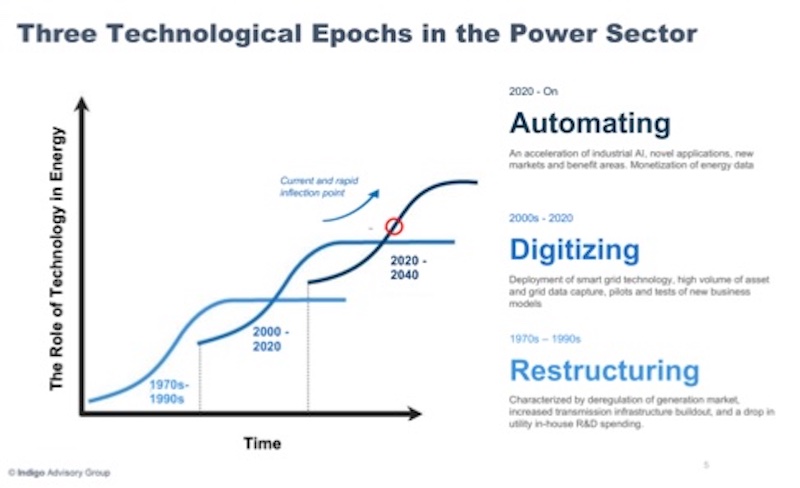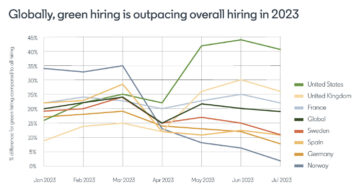With all of the grandiose predictions about how artificial intelligence will transform the economy and humanity, it’s easy to lose sight of how AI will manifest in specific sectors.
For the power sector, the promise is profound: AI could be the missing link that enables a truly digitized, distributed, decarbonized and democratized energy system. But today there is a massive chasm between this vision and reality. The current U.S. power system is built for another era, and it lacks the real-time, granular data needed for AI to realized its potential.
We are entering the era of automation
David Groarke, managing director of the utility consultancy Indigo Advisory Group, offered a narrative that helped me make sense of this moment last week as I navigated the Transition AI conference in Boston. AI is more than a technology; it is a harbinger for a new epoch for the utility sector.
Here’s the arc:
-
In the 1970 to 1990s, the power sector entered an era of restructuring, which tracked along the emergence of renewable energy.
-
From 2000 to 2020, the sector entered an era of digitization, which powered the start of the energy transition.
-
Starting in 2020, we entered the era of automation, which is supercharged by AI and will help drive net-zero goals.

As we move into that third era, solution providers and startups aim to capitalize — promising to leverage data to make power systems more resilient, efficient and cleaner. There are already hundreds of these startups racing to leverage new technologies to drive value (and hopefully other benefits) for utilities.
Machine learning, for example, can use algorithms to learn data patterns for applications such as predictive maintenance, energy forecasting and outage management. Distributed AI would allow intelligence to be distributed across devices to enable decentralized decision-making and deeper penetration of distributed energy resources.
All of these solutions are dependent on the same prerequisite: the availability of good, clean data.
AI is only as good as its data
Getting plentiful, trustworthy and high-quality data may be the biggest barrier to realizing the value of AI. Here are three ways data must get better for the power sector to be up for the challenges of the future.
Quantity
Simply put, we don’t have enough data. To deploy AI meaningfully, we’d need to know what’s happening across the electric grid and at the grid edge. The gap is not marginal — understanding how components interact with one another would require an order of magnitude change in the amount of data captured.
Getting that data will require a massive investment in technologies that may not immediately pay back.
“One thing [companies] should not underinvest in in 2023 is data capture and computational horsepower,” said Jess Melanson, chief operating officer of software company Utilidata. “While it may seem expensive in the narrow lens of investment, it’s going to be what saves you money time and time again as you build new software applications.”
Further, that data will need to be more nuanced than what today’s digitized technologies provide. For resource balancing, for instance, distributed energy resources would need to have data available at the millisecond level — something that largely doesn’t exist right now.
Quality
Those in the power sector will need data engineers to work closely with the underlying data to clean it and make sure it’s of high quality. This role is different from data scientists, who try to glean insights from data, or software engineers, who help integrate algorithms into products.
All this data must be provided in accessible formats, and the industry will likely need standardization to ensure available information can be shared across stakeholders and applications.
Different parts of the power sector do this better than others today. From the transmission perspective, utilities are federally required to share accurate data to ensure reliability through the interconnected grid — although more granular information is still needed.
From the device perspective (electric vehicles and energy storage), more is needed to understand individual loads — and to trust the data that emerges. After all, energy markets tend to be conservative in implementing innovations.
Context
Assuming we’re able to gather enough high-quality data, those building and deploying applications of AI for the energy sector must be vigilant of the context in which that information is collected and used. Failure to do so may reinforce current systems of bias, warned Priya Donti, executive director of Climate Change AI, a nonprofit that works to catalyze machine learning to address climate solutions.
“Dealing with bias requires looking not just at the narrow frame of what is the data and what is the specific technical system but also looking at the broader social context in which you’re developing your algorithm,” Donti said.
One example is the use of machine learning to predict which buildings are more likely to succeed in energy retrofits. While this may be a useful application for targeting retrofit activity, it could inadvertently reinforce discrimination if it ignores the U.S. history of redlining and underinvestment in communities of color.
What’s at stake? Getting AI wrong could lead to adverse impacts on the power system, which, frankly, is already struggling to cope with climate change and aging infrastructure. What’s more, getting AI wrong could reduce trust on technologies that could have strengthened the grid.
The days of AI in the power sector are still early, and there are sure to be many developments as companies make sense of this strange new world. What AI things are you (or your company) thinking about? Let me know at [email protected].
- SEO Powered Content & PR Distribution. Get Amplified Today.
- EVM Finance. Unified Interface for Decentralized Finance. Access Here.
- Quantum Media Group. IR/PR Amplified. Access Here.
- PlatoAiStream. Web3 Data Intelligence. Knowledge Amplified. Access Here.
- Source: https://www.greenbiz.com/article/profound-promise-ai-power-sector
- :is
- :not
- $UP
- 10
- 2020
- 2023
- 22
- 8
- a
- Able
- About
- accessible
- accurate
- across
- activity
- address
- adverse
- advisory
- After
- again
- Aging
- AI
- aim
- algorithm
- algorithms
- All
- allow
- along
- already
- also
- Although
- amount
- an
- and
- Another
- Application
- applications
- Arc
- ARE
- article
- artificial
- artificial intelligence
- AS
- At
- Aug
- availability
- available
- back
- balancing
- barrier
- BE
- benefits
- Better
- between
- bias
- Biggest
- boston
- broader
- build
- Building
- built
- but
- by
- CAN
- capitalize
- capture
- captured
- Center
- challenges
- change
- chasm
- chief
- Chief Operating Officer
- Climate
- Climate change
- closely
- collaborative
- color
- Communities
- Companies
- company
- components
- Conference
- conservative
- consultancy
- context
- continue
- could
- Current
- data
- Days
- dealing
- decentralized
- Decision Making
- deeper
- democratized
- dependent
- deploy
- deploying
- developing
- developments
- device
- Devices
- dialogue
- different
- digitized
- Director
- Discrimination
- distributed
- do
- Doesn’t
- Dont
- drive
- Early
- easy
- economy
- Edge
- efficient
- Electric
- electric vehicles
- emergence
- emerges
- enable
- enables
- energy
- Engineers
- enough
- ensure
- entered
- entering
- epoch
- Era
- Ether (ETH)
- example
- executive
- Executive Director
- exist
- expensive
- experience
- Failure
- federally
- For
- FRAME
- Free
- from
- future
- gap
- gather
- get
- getting
- Goals
- going
- good
- Grid
- Group
- Happening
- Have
- help
- helped
- here
- High
- high-quality
- history
- Hopefully
- How
- How To
- HTTPS
- Humanity
- Hundreds
- i
- if
- immediately
- Impacts
- implementing
- in
- Indigo
- individual
- industry
- information
- Infrastructure
- innovations
- insights
- instance
- integrate
- Intelligence
- interact
- interconnected
- into
- investment
- IT
- ITS
- jpg
- june
- just
- Know
- largely
- Last
- lead
- LEARN
- learning
- Lens
- let
- Level
- Leverage
- likely
- LINK
- loads
- looking
- lose
- machine
- machine learning
- maintenance
- make
- management
- managing
- Managing Director
- many
- Markets
- massive
- May..
- me
- millisecond
- missing
- moment
- money
- more
- move
- must
- NARRATIVE
- Need
- needed
- net-zero
- New
- New technologies
- node
- Nonprofit
- now
- of
- offered
- Officer
- on
- ONE
- online
- only
- operating
- or
- order
- Other
- Others
- outage
- parts
- patterns
- Pay
- penetration
- perspective
- plato
- Plato Data Intelligence
- PlatoData
- potential
- power
- powered
- predict
- Predictions
- Products
- profound
- promise
- promising
- protected
- provide
- provided
- providers
- put
- quality
- racing
- RE
- real-time
- Reality
- realized
- realizing
- reduce
- reinforce
- reliability
- Renewable
- renewable energy
- require
- required
- requires
- resilient
- resource
- Resources
- right
- Role
- s
- Said
- same
- scientists
- sector
- Sectors
- seem
- sense
- Share
- shared
- should
- Sight
- So
- Social
- Software
- solution
- solution providers
- Solutions
- something
- specific
- stake
- stakeholders
- start
- Startups
- Still
- storage
- Struggling
- succeed
- such
- sure
- system
- Systems
- targeting
- Technical
- Technologies
- Technology
- than
- that
- The
- The Future
- There.
- These
- thing
- things
- Thinking
- Third
- this
- those
- three
- Through
- time
- to
- today
- today’s
- Transform
- transition
- truly
- Trust
- trustworthy
- try
- u.s.
- underlying
- understand
- understanding
- use
- used
- utilities
- utility
- value
- Vehicles
- vision
- ways
- we
- week
- weekly
- What
- What is
- which
- while
- WHO
- will
- with
- Work
- works
- world
- would
- Wrong
- you
- Your
- zephyrnet









